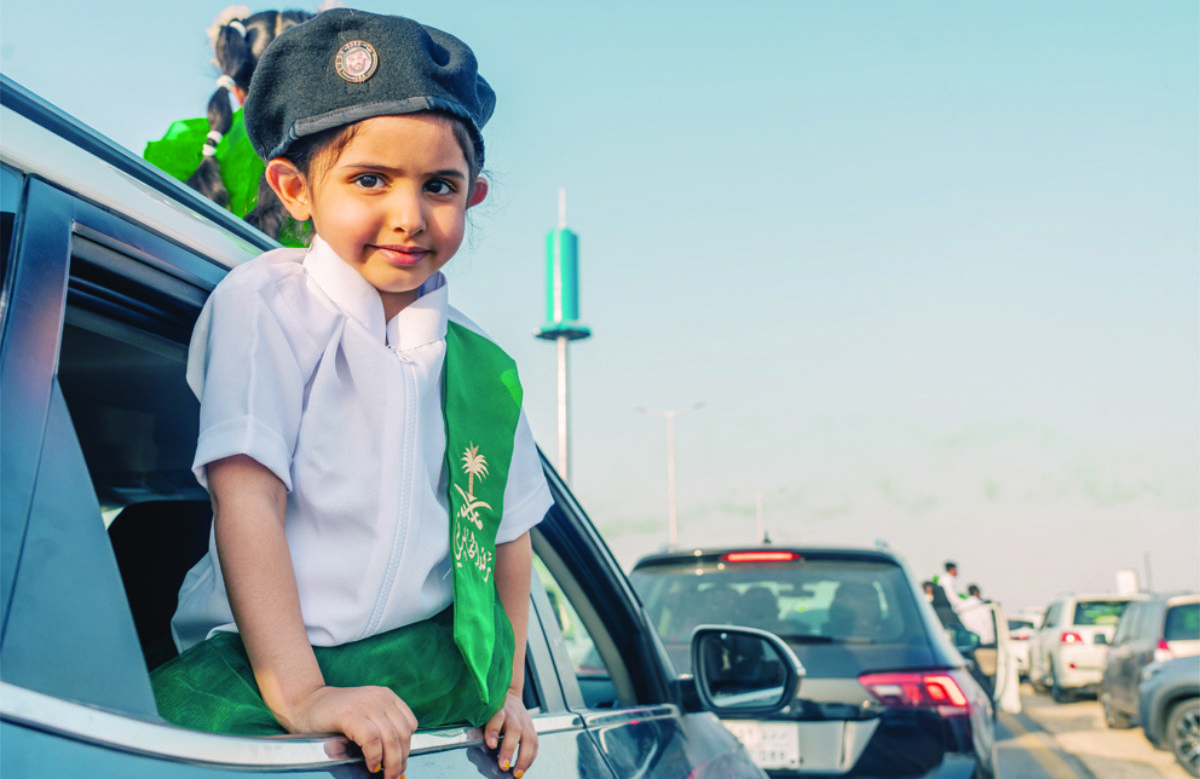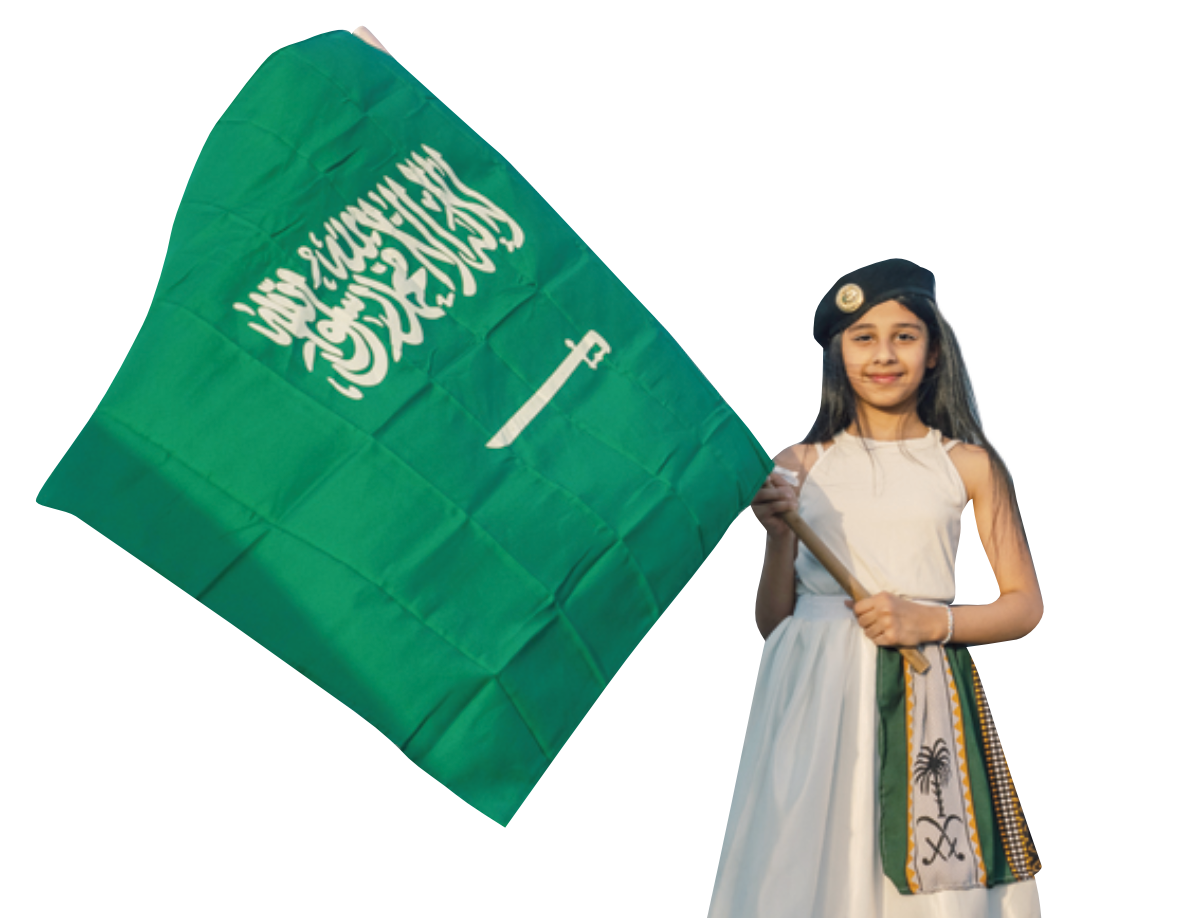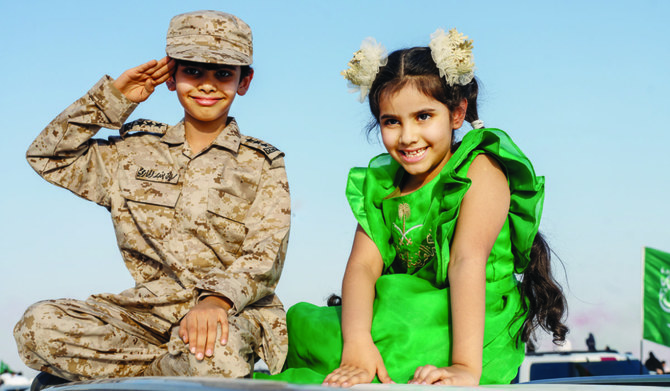JEDDAH/DHAHRAN: Residents marked the 93rd Saudi National Day over the weekend with great fervor as they took part in celebratory activities organized across the Kingdom’s regions, captivating audiences and instilling a sense of national pride.
A parade of naval vessels and special marine security boats, helicopter airshows and spectacular aerial ballet by the Royal Saudi Air Force were on show in different cities of the Kingdom. A military parade featuring an array of vehicles and infantry and cavalry units was also held. The Jeddah Waterfront became a focal point of celebration as enthusiastic crowds gathered to savor the day’s activities.
Rehab Al-Dossary, a student at King Abdulaziz University, said: “My family is a big fan of the air shows. It is clear that great efforts were made here.”

Children dressed up in military uniforms and the Kingdom’s national colors — green and white — were seen celebrating the Saudi National Day in Riyadh. (AN photos by Huda Bashatah)
Jeddah Art Promenade witnessed a two-hour folkloric show that showcased Saudi Arabia’s rich cultural heritage.
At the Jeddah Yacht Club, the Royal Guard held a parade and the Saudi Hawks Aerobatic Team executed intricate formations and aerial displays, leaving spectators spellbound.
The historic area of Al-Balad saw musical performances, a delectable array of food trucks, traditional folk dances, educational workshops, live shows, and guided tours that allowed both locals and visitors to immerse themselves in the rich cultural tapestry of Saudi Arabia.
FASTFACT
A parade of naval vessels and special marine security boats, helicopter airshows and spectacular aerial ballet by the Royal Saudi Air Force were on show in different cities of the Kingdom.
As guests arrived, they were warmly welcomed in the traditional Saudi way, with Arabic coffee and genuine hospitality.
The air was filled with enchanting melodies as singers and musicians occupied various areas within the historic district, mesmerizing the audience with their performances.

At the Jeddah Yacht Club, the Royal Guard held a parade and the Saudi Hawks Aerobatic Team executed intricate formations and aerial displays, leaving spectators spellbound. (AN photos by Huda Bashatah)
A kids’ corner ensured that little ones had their fair share of fun and entertainment too.
The Royal Institute for Traditional Arts, in partnership with The Prince’s Foundation School of Traditional Arts, held family-oriented activities during Saudi National Day celebrations in Al-Balad.
These included workshops on traditional arts like intricate geometric pattern drawing and hands-on woodcarving sessions.
Suzan Al-Yahya, CEO of the institute, said: “Saudi National Day reminds us of our cultural richness and the Kingdom’s commitment to preserving and promoting traditional art. Through our collaborative workshops, we aim to nurture local talent, provide training, and inspire the community to embrace Saudi Arabia’s artistic heritage.”

Saudis across the Kingdom have been taking to flag-decked streets in their thousands on Saturday to celebrate the Kingdom’s 93rd National Day. (AN Photo by Huda Bashatah)
Art enthusiasts were delighted by the diverse range of artworks showcased at the Visual Arts Gallery on Abu Inabah Street.
Traditional games at Al-Falah Courtyard brought people together, fostering a sense of camaraderie and friendly competition. A treasure hunt added an element of adventure to the festivities.
In collaboration with Infuse Advisory, Jeddah’s finest chefs opened a three-day pop-up restaurant, Peninsula, at Tahreek Space — a gastronomic initiative that celebrated the diversity of Saudi cuisine, infusing traditional flavors with contemporary trends.
Hashim Nazer, CEO of Infuse Advisory, told Arab News: “Peninsula Pop-Up offered a culinary journey, diving deep into the distinctive flavors emblematic of Saudi cuisine. In tribute to the 93rd Saudi National Day, and as a nod to our rich heritage, the menu has been meticulously curated by the dedicated Saudi chef team at Infuse Advisory, which includes Dana Al-Maddah, Abdulrahman Enani, and Taleen Miliany. While it pays homage to our traditions, the menu also captures the nation’s progressive stride towards contemporary trends.”
The menu showcased a fresh take on beloved Saudi classics, innovating with textures, presentation, and culinary techniques while staying true to the authentic flavors and spices that define traditional Saudi cuisine.
At the King Abdullah Economic City, residents enjoyed a traditional Saudi folk band show, an outdoor Arabesque seating area, and other entertaining activities.
Bay La Sun Hotel at KAEC hosted a grand celebration with live music, cultural shows, exquisite dining, and activities for children.
Sheraton Jeddah Hotel celebrated by honoring Saudi heritage with a buffet of traditional flavors, dance performances, and a commitment to authentic Arabic hospitality.
“Through our National Day celebration, Sheraton Jeddah Hotel aimed to honor the rich heritage of Saudi Arabia and provide our guests with an unforgettable experience that showcased our commitment to authentic Arabic hospitality,” said General Manager Edwin Wijkhuijs.
In Dhahran, the iconic King Abdulaziz Center for World Culture, or Ithra, was lit in a neon green with rays of white as it welcomed visitors young and old for the Kingdom’s three-day celebration.
One big attraction — and perhaps the most photographed — was the Aramco-commissioned large painting, titled “Sights of Grandeur.” The oil on canvas framed art piece was created especially for the 93rd National Day by artist Simon Pasini and depicts the previous late Saudi kings as they walk in unison down steps. The painting shows women standing prominently to the side, with familiar Saudi buildings in the background, including the Ithra building.
“We celebrate our homeland, the great anniversary of its unification; a day of strength, pride and renewed belonging,” Ithra said in a statement.
The “Sing Along for Saudi” karaoke experiment returned with two nightly shows, encouraging audience members to sing from their seats. Popular Saudi song lyrics were displayed on a big screen, accompanied by a live orchestra led by Maestro Yahya Musawa.
With 2023 designated as the Year of Arabic Poetry by the Kingdom, the Ithra Museum offered an Arabic Poetry Exhibit, along with musical performances at the Plaza and the famous Selfie Corner.
As the sun dipped below the horizon, the night skies across Saudi Arabia were illuminated by breathtaking fireworks displays.
Cities like Jeddah, Alkhobar, Madinah at King Fahad Main Park, Taif at King Abdullah’s Public Park, Hail’s Al-Salam Park, Abha’s Al-Sadd Garden and Al-Fan Street, and Tabuk Rose Garden all came alive with dazzling bursts of color and light.


























